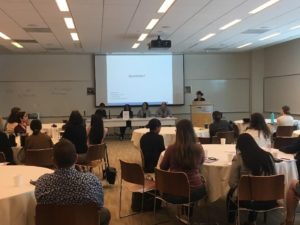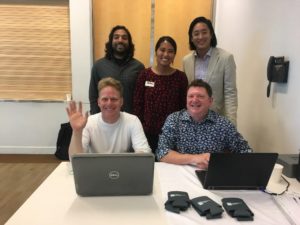Planning for Public Health: It’s Complicated

Written by Samantha Miyamoto, MPH
On June 28, 2019, a group of 41 stakeholders came together at Planning for Public Health: Taking Action Through Policy and Design, American Planning Association, Los Angeles Section (APA Los Angeles)’s first official event and foray into the national Plan4Health initiative.
Plan4Health is an initiative co-sponsored by APA and the American Public Health Association (APHA). More information can be found here. The APA Los Angeles team chose to focus on two aspects of life in LA that have great impact on our communities: increased heat and air quality.
We came in pursuit of understanding the challenges and currently available solutions to address these issues. We sought an integrated discussion approach to achieving public health goals through urban planning, policy, and design. Public health and urban planning are perhaps two proverbial birds of a feather, but from observation, they may not always flock together. The opportunity to participate in Plan4Health to bring together these professions fascinated me.
 APA Los Angeles was lucky to have fantastic public health and urban planning panelists from the LA County (Chief Sustainability Office, Department of Public Health), the City of Los Angeles and Bureau of Street Services, TreePeople, UCLA Luskin School of Public Affairs, Keck School of Medicine of USC, and Long Beach Alliance for Children with Asthma. We heard both the challenges and the solutions. Not to be facetious, but there are quite a few. For heat mitigation, solutions include utilizing cooler pavement strategies, increased tree canopy coverage, comprehensive policy support, and pre-intervention data analysis. For air quality improvement, solutions include developing roadside barriers, optimizing ventilation systems, and increasing community-based organization participation and exposure awareness. Implementation continues to be a challenge.
APA Los Angeles was lucky to have fantastic public health and urban planning panelists from the LA County (Chief Sustainability Office, Department of Public Health), the City of Los Angeles and Bureau of Street Services, TreePeople, UCLA Luskin School of Public Affairs, Keck School of Medicine of USC, and Long Beach Alliance for Children with Asthma. We heard both the challenges and the solutions. Not to be facetious, but there are quite a few. For heat mitigation, solutions include utilizing cooler pavement strategies, increased tree canopy coverage, comprehensive policy support, and pre-intervention data analysis. For air quality improvement, solutions include developing roadside barriers, optimizing ventilation systems, and increasing community-based organization participation and exposure awareness. Implementation continues to be a challenge.
This event taught me that there are multiple organizations and constituents concerned about the confluence of the systems creating today’s realities – the systems that either improve or negatively impact the socioeconomic determinants of health. These entities are working hard to not only mitigate issues but also improve general wellness.
It was encouraging to see various community members provide feedback in the form of a post-event survey on impressions and lessons learned from the event as well. Some feedback I received indicated that as a whole, we still “lack a coherent strategy”. It’s a hard but necessary realization to come to, even amidst all the work we do. We need to define this strategy. But no agency or entity can do it alone.
 While I would consider this first event run generally successful, much work remains to provide answers to the professional and general community’s burning questions on improving health by mitigating the impacts of heat and poor air quality through the built environment and design.
While I would consider this first event run generally successful, much work remains to provide answers to the professional and general community’s burning questions on improving health by mitigating the impacts of heat and poor air quality through the built environment and design.
The community at large still wants answers. They want opportunities to discuss their perspectives and provide possible solutions. We gave them one opportunity here, but we need to give them more.
As working urban planning and public health professionals (and as community members, I would also argue), we have a moral imperative to act (and to act quickly and efficiently) with the best available technologies to mitigate the negative impacts of high heat and harmful air quality. In the process of creating our professional communities, we so often segment ourselves and forget to talk to one another, to learn from others’ experiences and expertise. At the risk of speaking for others, we forget the impacts of working in siloed environments. This must change.
Fictional President Jed Bartlet once quoted in an episode of the West Wing, “Change comes in excruciating increments to those who want it.” While I find that truism to be generally true, perhaps we can try to buck the trend in our own work. To a better future!
Samantha Miyamoto is the ad hoc committee chair for American Planning Association, Los Angeles Section (APA Los Angeles)’s Plan4Health initiative.
— This post reflects the views of the author and not those of APA Los Angeles as an organization. —





